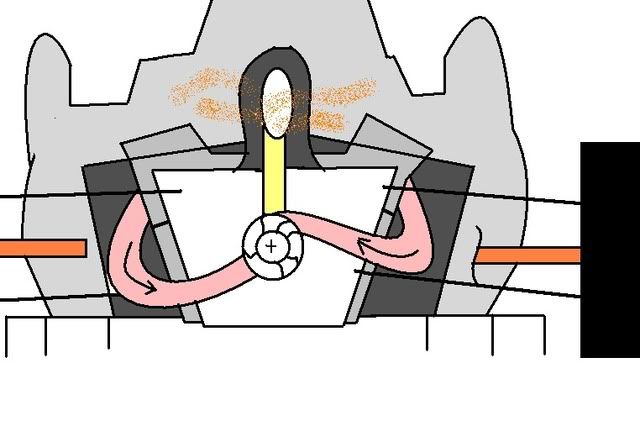Well, to answer the question,
something that nobody ever does in this forum of deranged and vagarious souls (exception made of 747heavy but he is also Spaniard, olé, viva Alonso and King Juan Carlos!) I will try some numbers, you hippies.
I am making a lot of guesses and assumptions that I know are not correct, sure, but I have a few minutes. This caveat/lame excuse/temptation is for my many pedantic, yet dear friends: correct me if you dare!

Simple:
You have a 18.000 rpm, 2.4 liters engine. This means (not taking in account the delay in valve opening between TDC and actual opening of valve, gimme a break, will ya?) that at the intake you have, if you are at full throttle:
9.000 rev/min x 2.4 liters/60 seg/m = 360 liters/second
A liter of air weighs around 1.2 grams. So thin and yet so refreshing!
I'll assume that the track is at 300 Kelvin, that is, 27 degrees Celsius, which is a relatively hot day in the "land of pretty and beautiful women", where I stand shirtless right now, but it is also a similarly pretty and beautiful round number.
I also will assume that exhaust gas temperature (EGT) is around 1500 Fahrenheit from what I know of EGT vs air to fuel ratio.
I'd say EGT it goes from 1250 to 1800 Fahrenheit, but 1500 is a nice round number and it has a 5 in it, a number I like so much that I will take a rum because of it.

That is around 1100 degrees Kelvin (give or take).
I don't like to use calculators nor computers, only my trusty slide rule, as everybody in this forum does, so let's round it to 1200 Kelvin.
I will assume that the exhaust pressure is 4 bars. This is a
huge assumption as I actually have no idea and the calculations are really complicated, but since when have engineers been deterred of assuming things they have no idea? Let's toast again to that.
I will also assume that after the turbine you have 1 bar, no major discussions here. I will also assume things are adiabatic (like they always are in books) and that isentropy should be around 85% (another 5!).
So:
The temperature at the exit of the turbine is given by Texhaust/Tintake = (1 bar/4 bars)^(1-1/Gamma)
Gamma should be around 1.4. So, if the intake is at the 1200 Kelvin I assumed, then:
T exhaust = 1200 * (1/4) ^ (1-1/1.4) = 1200 * (1/4) ^ (0.3)
This is around 795 Kelvin (it must be right, as it has a 5 in it).
So, the ideal temperature change is around 400 Kelvin (1200-795).
As the isentropy I assumed is 85%, then the real temperature change is about 400 * 0.85 = 350 degrees Celsius.
Let's toast to that, again. Hip. Actually, I will take another rum every time I get a 5.
Now, as Phi plus P is equal to change in enthalpy, and I assumed it is an adiabatic process, then Phi is zero.
So, P = flow of air * Cp * Change in temperature.
The mass of air is 360 liters per 1.2 grams/liter, this is 432 grams per second. So, let's round it to 500 grams per second. Another rum for that!
Now, Cp is about 1000 Joules per degree Kelvin per kilogram, isn't it?
So, P = 0.4 kg/s * 1000 Joules/ degree-kg * 350 degrees = 140.000 Joules/s
This is around 140.000/746 = 185 HP, give or take.
A fourth of the power goes out of the engine through the exhaust? No wonder the Poles are melting.
Where did I make a mistake?
My god, this was too much rum and I still have to make lunch. Your fault, Manchild. This means I'm going to raise my Spanish flag right now and hum (it has no lyrics!) the Spanish anthem, in vengeance. Viva el rey! Hip.



